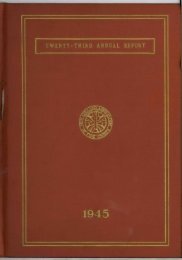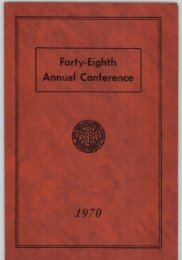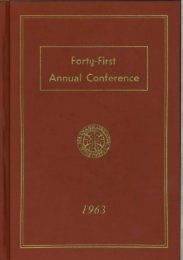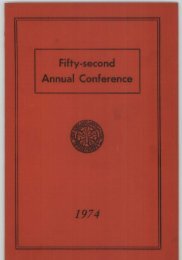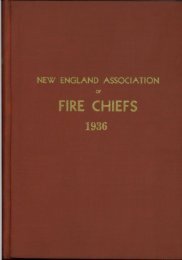NEAFC 31st Annual Conference.pdf - New England Association of ...
NEAFC 31st Annual Conference.pdf - New England Association of ...
NEAFC 31st Annual Conference.pdf - New England Association of ...
You also want an ePaper? Increase the reach of your titles
YUMPU automatically turns print PDFs into web optimized ePapers that Google loves.
NEW ENGLAND ASSOCIATION OF FIRE CHIEFS<br />
determine the probable gases which are being or will be distributed in your town and<br />
making your plans accordingly.<br />
For those <strong>of</strong> you who have natural gas pipelines in your area, I would cite live<br />
principal points to be observed if and when a pipeline break should occur in your area.<br />
First, keep people away from the area <strong>of</strong> gas leakage an,d keep all sources <strong>of</strong> fire away.<br />
Second, notify the nearest <strong>of</strong>fice <strong>of</strong> Northeastern Transmission Company or the local<br />
gas company or both. Third, avoid confinement in any area <strong>of</strong> gaseous atmosphere<br />
where there may be insufficient air for breathing. Fourth, if necessary to enter such<br />
areas, use an air-type gas mask. If possible, check the area for explosive possibilities with<br />
a combustible gas indicator. Fifth, if a fire occurs, extinguish it by one <strong>of</strong> the following<br />
methods:<br />
A. Dry-type chemicals.. B. Fog nozzles. C. Steam.<br />
We have found that the dry-type chemical is the most effective in extinguishing<br />
gas fires, and that .it is very successful where properly u.sed. You, as firemen, are doubtless<br />
much more familiar with the proper method <strong>of</strong> application <strong>of</strong> these various fire-fighting<br />
agents than I am.<br />
In order to provide maximum safety <strong>of</strong> operation, Northeastern has what we believe<br />
is the most modern equipment available. We maintain regular airplane patrols <strong>of</strong><br />
our pipeline by low,flying plane to observe any con, ditions which might create a hazard<br />
to the pipeline. The pilot is equipped with ’short-wave radio, and all <strong>of</strong> our maintenance<br />
crews have such short-wave radio communication equipment in their trucks and<br />
automobiles. These un.its are in constant communication with central stations at I-I.otliston,<br />
Springfield and Shehon. Any unusual or hazardous conditions observed by the<br />
pilot will be immediately radioed to the nearest maintenance crew and the hazard<br />
taken care <strong>of</strong>. We have installed automatic closing devices on all pipeline valve’s 16"<br />
and larger in size so that if a break in the pipeline occurs, the valves on each side <strong>of</strong><br />
the break will automatically close immediately--thus isolating the break and allowing<br />
the gas to dissipate.<br />
We have installed what is known as telemetering equpiment, whereby we have<br />
a continuous chart record in our Springfield Dispatching Office <strong>of</strong> pressures at all strategic<br />
points in the pipeline system. The instruments are located at points from Concord,<br />
<strong>New</strong> Hampshire, to ’Greenwich, Connecticut, and the info,rmation is transmittedby<br />
leased telephone wire. Any unusual conditions in the system are immediately indicated<br />
on the charts in, the Springfield Office, andl maintenance crews are dispatched accordingly.<br />
We maintain operating crews, at Springfield and Holliston, Massachusetts, and<br />
Shelton, Connecticut. In addition, each <strong>of</strong> our customer companies is a source <strong>of</strong> quick<br />
contact between us and the public, a’s all are familiar with the location <strong>of</strong> our pipelines<br />
and the operation <strong>of</strong> our metering and regulator stations..<br />
Those <strong>of</strong> you who have pipelines, in your towns are, doubtless, familiar with the<br />
location. However, generally speaking, our pipeline system starts in Berkshire County<br />
at the <strong>New</strong> York-Ma, sachusetts State line west .<strong>of</strong> Pittsfield, and runs generally in a<br />
southeasterly direction through the Towns <strong>of</strong> ’Richmond, Stockbridge, Lee, Tyrringham,<br />
Otis, Sandisfieldl, Tolland, Granville, Southwick, and Agawam to the Connecticut<br />
River. From there it runs generally easterly through Longmeadow, East Longmeadow,<br />
Hamden, Monson, Wales, Tolland, Sturbridge, Charhon, Oxford, Sutton, Lexington,<br />
Burlington, and Wilmington. In Connecticut, the main line system starts in the Towr<br />
<strong>of</strong> Greenwich and runs northeasterly through Stamford,, <strong>New</strong> Canaan, Norwalk, West-<br />
201



